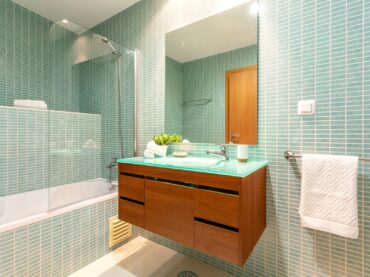 DIY home improvement projects are a popular way to save on costs, and tiling is one of the most approachable renovation tasks homeowners can take on. However, the U.S. Geological Survey reports that over 85% of American homes have hard water, which can significantly impact tile durability and appearance. The minerals in hard water often lead to stubborn stains and buildup, affecting both the aesthetics and longevity of tiled surfaces.
DIY home improvement projects are a popular way to save on costs, and tiling is one of the most approachable renovation tasks homeowners can take on. However, the U.S. Geological Survey reports that over 85% of American homes have hard water, which can significantly impact tile durability and appearance. The minerals in hard water often lead to stubborn stains and buildup, affecting both the aesthetics and longevity of tiled surfaces.
To help ensure your next tiling project stands the test of time, the experts at Mineral Tiles have compiled nine top tips to guide you in choosing tiles that will last, even in challenging water conditions.
Henry Maia, a tile expert at Mineral Tiles, explains, “The type of water in your home plays a big role in how well your tiles hold up over time. Understanding your water can help you choose tiles that are easier to clean and maintain their appearance longer. The right tile selection can be the difference between a showroom-fresh look and the constant hassle of stains and damage.”
Know Your Water
Before selecting tiles, test your water hardness. Hardware stores sell simple test kits that can tell you if you have hard water (typically above 7 grains per gallon). Hard water contains high levels of calcium and magnesium, which can lead to mineral buildup on tiles.
The higher the mineral content, the more likely you are to face issues like scaling and staining. For example, areas with over 10 grains per gallon are considered very hard water zones and require extra consideration when choosing tiles. Understanding your water’s mineral content helps you select tiles that can withstand these conditions, reducing maintenance in the long run.
Choose Materials Wisely
If you have hard water, opt for dense, nonporous tiles like porcelain or glass. These materials resist mineral buildup and staining because they do not absorb water or minerals. Porcelain, for instance, is fired at higher temperatures, making it harder and more durable than many other types of tiles.
In contrast, natural stone tiles, while beautiful, are porous and can easily absorb minerals, leading to staining and dulling over time.
Soft water areas with lower mineral content allow for more flexibility in material choices, including natural stones, as they are less likely to experience significant buildup.
Consider Grout Color Carefully
In hard water areas, darker grout colors can be more forgiving because they hide the light-colored stains that mineral deposits often leave behind. Hard water stains are usually white or grayish due to the calcium and magnesium left behind as water evaporates.
Lighter grout can quickly become discolored, requiring more frequent cleaning and maintenance to keep it looking fresh. Darker grout, on the other hand, camouflages these deposits, reducing the appearance of wear and tear over time.
You Don’t Have to Sacrifice Style for Practicality
You don’t have to choose between style and practicality when selecting tiles. Manufacturers offer a wide range of tiles that balance both, such as porcelain tiles that mimic the look of natural stone or wood. This allows you to achieve your desired aesthetic without compromising on durability.
When choosing tiles, request samples and see how they look in your space after a few weeks of typical use. This can help you find a tile that meets both your style and functional needs, ensuring you’re happy with the result.
Think About Texture
Heavily textured tiles can be beautiful, but in hard water areas, they may trap mineral deposits more easily, leading to increased maintenance.
If you’re set on textured tiles, consider using them in less exposed areas such as backsplashes, accent walls or decorative borders where they are less likely to come into contact with water.
For high-moisture areas like shower walls or bathroom floors, subtler textures are easier to clean and maintain.
Factor in Maintenance
Some tiles, especially natural stones, require more upkeep in hard water areas. For example, natural stone tiles need to be sealed regularly — typically every six to 12 months — to prevent water and minerals from penetrating the surface.
The sealing process involves applying a special sealant to the tiles and grout, allowing it to cure, and then wiping off any excess.
While this sounds straightforward, it’s time-consuming and adds to the long-term maintenance costs. If you’re not ready for this level of upkeep, opting for materials like porcelain can save you both time and effort.
Don’t Forget About Fixtures
While focusing on tiles, remember that faucets, showerheads and other fixtures are also affected by water type. In hard water areas, certain finishes, like brushed nickel or oil-rubbed bronze, are better at hiding water spots compared to shiny chrome finishes.
Additionally, fixtures can create hard-to-reach spots where mineral deposits accumulate, making them difficult to clean. Choosing fixtures with simpler designs and fewer crevices can help minimize this issue and make cleaning easier.
Size Matters
Larger tiles mean fewer grout lines, which is beneficial in hard water areas where mineral deposits can accumulate in the grout. However, larger tiles may be slippery when wet, particularly in bathroom floors or shower areas.
To counteract this, look for larger tiles with a slip-resistant surface or consider using smaller tiles with more grout lines in these specific areas to provide additional grip and safety.
Consider Long-Term Solutions
For homes with very hard water, installing a water softener or filter system could be a worthwhile investment. These systems reduce the mineral content in your water, which not only protects your tiles but also extends the life of your plumbing and appliances.
While costs vary, water softeners typically range from $500 to $2,500, including installation. Though this is an upfront expense, it can save you money in the long run by reducing maintenance and preventing damage to your home’s surfaces and systems.
“The key to smart tile selection is thinking beyond just looks — it’s about how those tiles will stand up to your daily life over the years,” Maia says. “Ask yourself: How much time do you really want to spend scrubbing grout lines every week? Or dealing with stubborn stains every month?”
Maia adds, “By considering not just the initial appeal but also the ongoing maintenance and care, you can choose tiles that fit seamlessly into your lifestyle. This means looking past the obvious choices and finding options that will stay beautiful with minimal effort, so you can enjoy your space without turning tile care into a part-time job.”




























